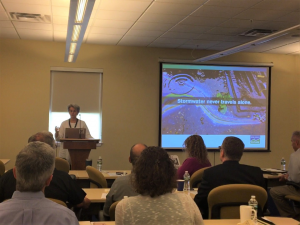New Jersey Future Blog
Proposed stormwater rule change means green infrastructure training for municipal engineers
June 24th, 2019 by Kenzie Smith
Six months after proposing significant amendments to New Jersey’s stormwater management rules NJAC 7:8), the New Jersey Department of Environmental Protection (NJDEP) is working diligently on responses to public comments. One of the proposed amendments signals a paradigm shift in design methods of stormwater management systems toward sustainability. The amended rule will likely be adopted by December of 2019 and take effect one year later, at which point the NJDEP standards for water quality, recharge and quantity control must be met using green infrastructure practices.
The professionals whose work will be directly affected — especially engineers — are beginning to focus in earnest on what the proposed rule changes will mean for them. At its June 5 quarterly meeting, the New Jersey Society of Municipal Engineers (NJSME) featured training about the rule changes.

Louise Wilson presents at NJSME’s quarterly meeting at the Palace at Somerset Park. Nearly every seat was filled, and attendees were eager to learn more about green infrastructure practices, challenges and benefits, and how anticipated changes to New Jersey’s stormwater rule will affect their work.
Louise Wilson, New Jersey Future’s green infrastructure director, opened the program with a brief overview of green infrastructure’s broad benefits, showing examples of green infrastructure in a variety of municipal sites including parks, streets and plazas. She described green infrastructure as a way to help sites and neighborhoods to function more like sponges, helping prevent runoff pollution and address the growing problem of flooding due to today’s heavier rains.
Jeromie Lange, senior principal at Maser Consulting, provided details of the recently proposed changes to the stormwater management rules, explaining how water quality, recharge and rate control standards must be met using a variety of small-scale and larger scale green infrastructure practices: rain gardens and other bioretention, stormwater planters and bumpouts, constructed wetlands, porous asphalt and permeable pavers, green roofs, cisterns, vegetative filter strips, wet ponds, etc. Lange described several projects with a variety of green infrastructure techniques and included helpful information about installation and maintenance.
Clay Emerson, practice area lead at Princeton Hydro, then wrapped up the program with a presentation about how the rule change would affect design practices and some common green infrastructure installation mistakes. He cautioned that certain common ways of calculating runoff “essentially dilute the impact of impervious coverage and under-predict runoff volume and flow rate,” and he explained the importance of separating the “curve numbers” in order to accurately calculate runoff volume. Emerson also discussed the dynamics of “groundwater mounding” and the importance of understanding soil properties on any given site.
The question and answer session was robust. Assuming the rule proposal is adopted, design professionals will need specialized training — which can be provided by NJDEP, academic professionals, and the private sector — to adjust to this paradigm shift. New Jersey Future looks forward to continued involvement in this process.















